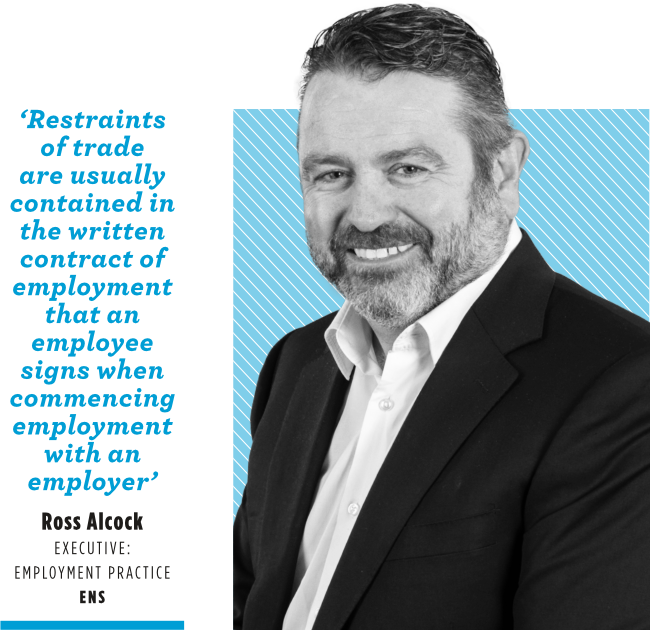An estimated 30 million Americans – one in five of the workforce – from the lowest-paid workers to CEOs are currently bound by a so-called non-compete agreement. This is according to the country’s Federal Trade Commission (FTC). Earlier this year, the FTC passed a motion to ban such clauses nationally, saying that ‘the freedom to change jobs is core to economic liberty and to a competitive, thriving economy’.
In one case it cited, a single father was forced to quit his job as an overnight security guard when his night-time childcare for his daughter fell through. He found a job as a daytime security guard that paid $15 an hour, $4 more than his previous job. But his old employer challenged his appointment because he had signed a non-compete, and his new employer fired him.
In another case, Illinois-based fast-food sandwich chain Jimmy John’s made all its employees sign non-competes, even its low-wage workers, barring them taking jobs at competitors for two years, according to Recruiter.com. And Jimmy John’s idea of competitor was particularly restrictive – ‘any business which derives more than 10% of its revenue from selling submarine, hero-type, deli-style, pita and/or wrapped or rolled sandwiches and which is located within three miles of […] any such other Jimmy John’s Sandwich Shop’. Jimmy John’s was later forced to withdraw its non-compete clauses and says it no longer uses them.
In Florida, a specialist neurosurgeon, the only one between Miami and Tampa who could offer a particular life-saving procedure, was sued by his former hospital because his new position at a hospital 35 miles away was in contravention of his 50-mile radius non-compete clause.
‘Forget protecting your business; when you make an employee sign an agreement that endangers people’s lives, you may want to rethink the necessity of that agreement,’ Matthew Kosinski, Recruiter.com managing editor, writes in an online post.
Many more examples of unnecessary non-competes have been cited, involving janitors, hairdressers, yoga instructors and even dog walkers.
The FTC ban, which was due to be enforced in the US in September, was overruled by a federal judge on the issue of jurisdiction. Individual states still have their own rules governing non-competes. In California, for example, there is a total ban on non-competes, and other states ban such agreements subject to a few exceptions.
FTC chair Linda Khan has argued that such clauses ‘systemically drive down wages, even for workers who aren’t bound by one. Every worker stuck in a job represents a position that isn’t opening up for someone else. And if employers know their workers can’t leave, they have less incentive to offer competitive pay and benefits, which puts downward pressure on wages for everyone’. She cites estimates suggesting the nationwide ban on non-compete clauses could increase workers’ earnings across industries and job levels by up to 4% annually. And a ban would also reduce racial and gender wage gaps could by up to 9%.
In the UK, meanwhile, non-competes are not statutorily restricted, but there are proposals to limit the duration of non-compete clauses in employment contracts to three months, according to Melissa Cogger, a partner at SA legal firm Bowmans.
Outlining the tension between the rights of employers versus employees’ rights, Cogger says ‘public policy in South African law requires that agreements freely entered into should be honoured. At the same time, public policy dictates that individuals should be free to take part in economic activities to earn a living’.
As with any agreement, employees are in theory not obliged to sign a restraint-of-trade clause. ‘While an employee is not obliged to conclude a restraint of trade with his/her employer, in reality restraints of trade are usually contained in the written contract of employment that an employee signs when commencing employment with an employer,’ says Ross Alcock, an executive in ENS’ employment practice. ‘It is often a term and condition of employment that an employee is required to agree to prior to commencing employment.’
C-suite executives of course may have more bargaining power in negotiating the terms of a restraint of trade.
If an ex-employee should breach the restraint-of-trade agreement, employers have recourse to the High Court or Labour Court. But this can be both time-consuming and costly. ‘By the time a court date is obtained, in certain cases the damage has already been done, leaving the employer with a decision on whether to proceed with a damages claim in the civil courts, which are often difficult to prove,’ says Cogger
Alcock makes an important point that the purpose of these agreements in SA is not ‘to stop an employee from competing with their former employer; rather, the purpose is to allow employers to protect their proprietary interests’.
Those proprietary interests include trade secrets (the employer’s confidential information) and trade connections (the employer’s customers, potential customers and/or suppliers). However, they have been held not to ‘include an employee’s expert knowledge acquired, either through training or by virtue of his employment, and therefore, an employee cannot be restrained from utilising his expert knowledge to further his economic interest’.
If a company goes to court to enforce a restraint-of-trade agreement it first has to ‘prove the existence of a prima facie valid and enforceable restraint’, says Alcock. The onus then shifts to the ex-employee, who ‘then bears the onus of showing on a balance of probabilities that the restraint is unreasonable and as such should not be enforced. To determine whether the terms of the contract are reasonable or not is a factual enquiry and would have to be conducted with reference to the facts of each case. A restraint-of-trade provision that prevents an employee from taking up employment with a competitor should therefore be clearly structured and should only seek to protect the proprietary interests of the employer. A restraint provision that is all-encompassing and far reaching, may well be viewed as unreasonable and unenforceable’.
Cogger cites a recent High Court ruling where an employee had accepted employment with a competitor and was alleged to have divulged confidential information, despite having ‘provided various undertakings to abide by the contractual clauses’.
While the court found the confidentiality clauses valid and binding, and ordered an interdict to prevent the employee and the competitor company from using or disseminating his former employer’s confidential information, it ruled that the restraint-of-trade clause was ‘unreasonable and unenforceable’.
The restraint-of-trade clause ‘sought to prevent the employee from working with any competitor for a year, simply because he had acquired specialised skills and know-how during his employment’.
According to Cogger, ‘the court found that the employee’s skills and know-how were inherent to him and there was an inequality of bargaining power when entering into the restraint of trade’. In this case the interdict was sufficient to protect the employer’s interests without restricting the individual’s employment opportunities, showing that a well-drafted confidentiality and intellectual property clause can be enough.
Cogger suggests that employers might consider ‘a gardening leave provision’, putting the ‘employee on ice for a period of time before termination of employment’, thus preventing them from being employed by a competitor during that time and also putting distance between the employee and customers.
She adds that companies are also protected against unlawful competition under common law, ‘wherein competitors may not unlawfully use trade secrets of competitors as a springboard in their own business’.










